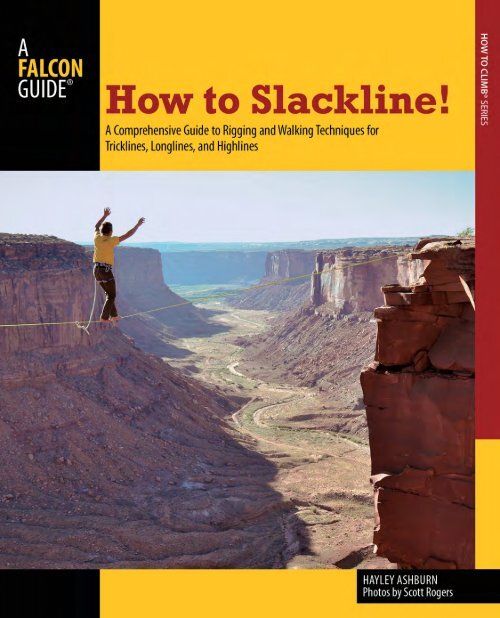How to Slackline! - Falcon Guides
How to Slackline! - Falcon Guides
How to Slackline! - Falcon Guides
Create successful ePaper yourself
Turn your PDF publications into a flip-book with our unique Google optimized e-Paper software.
Slacklining was once relegated <strong>to</strong> the select few<br />
climbers who had the knowledge and gear <strong>to</strong><br />
rig a slackline from scratch. Today slackliners come<br />
from all backgrounds. The introduction of easy<strong>to</strong>-assemble<br />
slacklines has transformed slacklining<br />
from an obscure offshoot <strong>to</strong> a full-fledged, modern<br />
extreme sport. <strong>How</strong>ever, while the mass production<br />
of slackline kits has produced a new generation of<br />
highly skilled balance athletes, it has also left those<br />
athletes ill-equipped <strong>to</strong> think critically about slackline<br />
rigging and <strong>to</strong> manage the full array of rock<br />
climbing gear needed <strong>to</strong> safely construct a longline<br />
or highline.<br />
I was lucky enough <strong>to</strong> be part of a community<br />
of rock climbers and slackliners that were, at the<br />
time, pushing the limits of slacklining, but it still<br />
<strong>to</strong>ok me years <strong>to</strong> learn the ins and outs of slackline<br />
rigging. Today I know just about every trick there<br />
is <strong>to</strong> rigging and walking slacklines, but the majority<br />
of that information is still passed from slacker<br />
<strong>to</strong> slacker by word of mouth and remains difficult,<br />
if not impossible, <strong>to</strong> learn without the help of an<br />
experienced slackliner.<br />
Owing <strong>to</strong> the infinite variety of slackline styles<br />
and locations, no book could ever cover every<br />
specific slackline rig. Each slackline is unique, the<br />
materials and methods determined by the nature<br />
of the anchors and style of the rigger. The purpose<br />
Introduction<br />
Jordan Tybon walking a highline in the Fisher Towers, Utah<br />
ix<br />
of this book is <strong>to</strong> explain the applications of the<br />
most common slacklining gear, and <strong>to</strong> put in simple<br />
terms the time-tested techniques for rigging safe,<br />
walkable slacklines in a variety of environments.<br />
There is no “right” way <strong>to</strong> rig a slackline.<br />
American highline guru Terry Acomb describes<br />
the phenomenon like this: “If you ask four different<br />
slackliners how <strong>to</strong> rig something, you’ll get<br />
five different opinions.” <strong>Slackline</strong> rigging is not a<br />
standardized practice. The type of line you rig will<br />
be determined by the type of line you like <strong>to</strong> walk.<br />
That’s what makes slacklining so wonderfully personal,<br />
and so difficult <strong>to</strong> learn. Each line is cus<strong>to</strong>mized<br />
by the slackliner who rigged it. Talking with<br />
other slackliners about rigging preferences is one of<br />
the best ways <strong>to</strong> learn more about slackline rigging.<br />
Studying this book will give you the <strong>to</strong>ols <strong>to</strong> weigh<br />
in on slackline rigging discussions and form opinions<br />
of your own.<br />
<strong>How</strong> <strong>to</strong> Use This Guide<br />
<strong>Slackline</strong> rigging and walking are progressions that<br />
go hand in hand. This guide moves through slackline<br />
concepts in ascending order of complexity and<br />
difficulty, assuming that the reader has no prior<br />
knowledge of slackline gear or rigging techniques,<br />
and working up <strong>to</strong> more advanced rigging and
Once slacklining was for experts only. Today<br />
children are one of the biggest sec<strong>to</strong>rs of the<br />
slackline community. Kids as young as 2 and<br />
3 can enjoy bouncing on the line with their<br />
parents.<br />
walking by building on concepts explained in earlier<br />
chapters.<br />
Start by learning how <strong>to</strong> walk a lowline, then<br />
get familiar with slackline gear and start rigging<br />
your own lines. More advanced slackline walking<br />
techniques are paired with chapters about rigging<br />
advanced lines. You don’t even need <strong>to</strong> think about<br />
how <strong>to</strong> walk a highline until you can confidently<br />
rig a good longline.<br />
This guide includes all the technical information<br />
you need <strong>to</strong> make informed decisions about<br />
what gear <strong>to</strong> invest in, including detailed descriptions<br />
of what gear is out there, what will work for<br />
slacklining, and how <strong>to</strong> use some of the newest<br />
innovations in slackline gear. What follows is a set of<br />
guidelines that provides a framework for safe slackline<br />
rigging illustrated by real-world examples and<br />
pho<strong>to</strong>s.<br />
x Introduction<br />
You will learn how <strong>to</strong> build a cus<strong>to</strong>m line that<br />
reflects your personal walking style while adapting<br />
<strong>to</strong> the specifics of any given location. You will learn<br />
how <strong>to</strong> build safe slacklines and <strong>to</strong> judge what is safe<br />
enough by evaluating the consequences of failure.<br />
You will learn how <strong>to</strong> make your rigging safer as<br />
you master longlining and highlining, in that order.<br />
If you are looking for information on a specific<br />
<strong>to</strong>pic, including knots, flip <strong>to</strong> the glossary and knots<br />
index in the back of the guide.<br />
Ethics<br />
<strong>Slackline</strong>rs have a special relationship with trees. No<br />
matter how good you get at slacklining, you will<br />
always be able <strong>to</strong> find a pair of trees that challenge<br />
your abilities. The problem with trees is twofold: (1)<br />
They are alive, and (2) somebody owns them. City<br />
officials across the United States are debating the<br />
slacklining issue because of the potential for damaging<br />
trees in public parks. One of the major goals of<br />
this guide is <strong>to</strong> set a standard for rigging that makes<br />
it easier for public officials <strong>to</strong> condone slacklining.<br />
<strong>Slackline</strong>rs need <strong>to</strong> understand that our lines<br />
put a great deal of force on trees, and can damage<br />
or even kill trees that are <strong>to</strong>o small. Even big trees<br />
need <strong>to</strong> be padded before affixing anchors. You<br />
don’t have <strong>to</strong> be a hippy <strong>to</strong> care about the trees, pad<br />
your anchors, and police your friends; if you don’t,<br />
slacklining could be banned in your home<strong>to</strong>wn.<br />
The second best slackline anchor, after trees, is<br />
a set of bolts. It’s easier <strong>to</strong> place a bolt than it is <strong>to</strong><br />
think creatively about how <strong>to</strong> use natural anchors.<br />
Unfortunately, bolts are permanent, and slackliners<br />
may unwittingly put bolts in a taboo location (such<br />
as in the middle of a climbing route or within sight<br />
of a hiking trail). Use this guide <strong>to</strong> learn alternate<br />
methods of rigging. It is considered extremely poor<br />
style <strong>to</strong> place a bolt where you could have rigged <strong>to</strong><br />
a boulder or tree instead.<br />
Talk <strong>to</strong> someone at the crag <strong>to</strong> learn local<br />
cus<strong>to</strong>ms, and research the rules and regulations of
Richard Webb walking a line using proper tree<br />
protection on the anchor<br />
any location before bolting. Even though many<br />
climbing crags seem so covered in bolts that a few<br />
more won’t matter, resist the temptation <strong>to</strong> bolt.<br />
It is these areas where rock climbers are especially<br />
sensitive about bolting. Bolting is discussed in this<br />
guide. I have bolted my own anchors. Know that<br />
all the bolts featured in this guide were legally<br />
installed in remote locations far out in the Utah<br />
desert.<br />
Critical Thinking and Community<br />
What this guide cannot provide is a checklist for<br />
how <strong>to</strong> rig a safe slackline. For that you will need <strong>to</strong><br />
think critically about gear and analyze locations as<br />
you find them. The best way <strong>to</strong> learn that skill is <strong>to</strong><br />
find a good slackline men<strong>to</strong>r <strong>to</strong> follow around and<br />
learn from. I was lucky enough <strong>to</strong> have slackline<br />
Here, I’m paying my dues on Andy Lewis’s<br />
world-record <strong>to</strong>wer highline: Leviathan<br />
legends like Andy Lewis and Mike Pay<strong>to</strong>n as my<br />
men<strong>to</strong>rs, along with a whole tribe of experienced<br />
slackliners and climbers from around the world.<br />
Some of what I learned from them is in this guide;<br />
a few even weighed in with opinions about how<br />
<strong>to</strong> rig and walk their favorite lines. I am forever<br />
indebted <strong>to</strong> them for teaching me not only how <strong>to</strong><br />
walk but also how <strong>to</strong> rig slacklines. They saved me<br />
from my own sketchy rigging on numerous occasions;<br />
it’s always good <strong>to</strong> have someone else around<br />
<strong>to</strong> double-check your work.<br />
You will need <strong>to</strong> find your own slackline<br />
tribe—people who love <strong>to</strong> slackline and argue<br />
about gear. Don’t be afraid <strong>to</strong> approach experts;<br />
they always need more backs for carrying gear, and<br />
it won’t matter <strong>to</strong> them if you can’t rig or walk the<br />
line. Just bring a big, empty backpack and I promise<br />
you’ll be welcomed with open arms.<br />
Introduction xi
Scott Rogers<br />
walking the<br />
Lost Arrow Spire<br />
Highline, one of<br />
the world’s most<br />
his<strong>to</strong>ric lines
The His<strong>to</strong>ry of Slacklining<br />
You may think of slacklining as a new sport or<br />
as something that is just now catching on. While<br />
balancing on webbing is a relatively new invention,<br />
rope walking has been around in some form<br />
or other since at least the Roman times, and likely<br />
earlier.<br />
Tightrope<br />
Reportedly, tightrope walkers put on spontaneous<br />
performances high above the streets of Rome and<br />
even in the Coliseum. The Romans called these<br />
artists funambula, and <strong>to</strong>day funambulist is the technical<br />
term for wire walkers, tightrope walkers, and<br />
slackliners.<br />
Ancient plaster paintings, buried for 1,700 years<br />
under the same volcanic ash that buried the ancient<br />
city of Pompeii, depict what look like small demons<br />
walking on what are unmistakably tightropes<br />
stretched over A-frames, a structure slackliners still<br />
use <strong>to</strong>day. This discovery stretches the written (or<br />
painted) record of tightrope walking as far back as<br />
AD 79.<br />
Tightrope walking is not only an old sport, but<br />
also a global one. His<strong>to</strong>rians can’t say how long the<br />
Korean tradition of Jultagi has been around, but it<br />
may have begun as early as 57 BC. Now considered<br />
part of Korea’s cultural heritage, Jultagi is a unique<br />
form of tightrope walking where performers combine<br />
acrobatic performance with music and acting.<br />
A group of Gibbon athletes visited Korea in<br />
2010 <strong>to</strong> appear on a television show about the similarities<br />
between slacklining and Jultagi, and were<br />
shocked <strong>to</strong> see traditional Jultagi performers doing<br />
many tricks very similar <strong>to</strong> those in slacklining. A<br />
between-the-legs butt-bounce is now named “The<br />
Korean” out of respect for a culture that has been<br />
performing it for more than 2,000 years.<br />
Across the globe, at the wedding of Charles VI<br />
<strong>to</strong> Isabel of Bavaria in 1385, a funambulist reportedly<br />
walked high above the royal wedding feast.<br />
A modern-day Jultagi performance in Jeonju,<br />
South Korea<br />
w i k i p e d i a c o m m o n s<br />
Rope walking was popular all over Europe for<br />
centuries, but didn’t make it across the Atlantic until<br />
the first American circus in 1793.<br />
Decades later, in 1859, Charles Blondin of<br />
France elevated rope walking <strong>to</strong> a high art when<br />
he made the first daring crossing of Niagara Falls<br />
on a single 3-inch hemp cord. Blondin walked the<br />
270-foot-high and over 1,000-foot-long line blindfolded,<br />
on stilts, even pushing a wheelbarrow—all<br />
with no safety harness or net of any kind.<br />
Highwire<br />
Until 1800 the term “tightrope” was correct,<br />
because artists used ropes. Tightrope walking is the<br />
art of walking on a rope tensioned between two<br />
points. <strong>How</strong>ever, what people usually mean nowadays<br />
when they say “tightrope walking” is highwire<br />
walking.<br />
Introduction xiii
The Flying Wallendas were the first act <strong>to</strong> make human pyramids on the highwire,<br />
with as many as nine artists on the wire at a time.<br />
k a r l w a l l e n d a<br />
Tightrope walking was much more difficult and<br />
dangerous than highwire walking. Around 1800 the<br />
Industrial Revolution advanced <strong>to</strong> a point where<br />
reliable cable was readily available, and most circus<br />
performers switched <strong>to</strong> rigging with this steel<br />
wire instead of the traditional round rope or cloth<br />
cord. This was the beginning of highwire walking,<br />
and artists could now perform much more technically<br />
difficult and eye-popping tricks like building<br />
human pyramids and riding bicycles across the<br />
wires.<br />
The modern highwire is made of a steel cable<br />
that is between 5 ⁄8 inch and 1 inch in diameter.<br />
xiv Introduction<br />
Highwires are tensioned and stabilized with supportive<br />
wires called guy wires, or cavalletti wires.<br />
Wire walkers commonly use a weighted pole for<br />
balance. The pole Philippe Petit used <strong>to</strong> walk the<br />
highwire between New York’s Twin Towers was 26<br />
feet long and weighed fifty-five pounds.<br />
The most iconic highwire walker in his<strong>to</strong>ry is<br />
probably Karl Wallenda of the Flying Wallendas, a<br />
famous circus act that began in Milan in 1922 and<br />
continues <strong>to</strong> perform <strong>to</strong>day. By the age of 16, Karl<br />
Wallenda, their founder, was doing handstands on<br />
the shoulders of a German wire walker 40 feet<br />
in the air. Karl would go on <strong>to</strong> make tightrope
walking world famous as an act in the Ringling<br />
Brothers Circus. At a performance of the Flying<br />
Wallendas in Acron, Ohio, in 1935, a guy wire<br />
came loose, causing Helen Wallenda <strong>to</strong> lose her balance<br />
and fall from the <strong>to</strong>p of the pyramid. She was<br />
miraculously saved by Karl, who stunned the crowd<br />
by catching her between his legs as he hung from<br />
the high wire by both hands.<br />
After that, wire walking was largely ignored by<br />
the press until Philippe Petit illegally rigged and<br />
walked a wire between the Twin Towers in 1974.<br />
After nearly ten months of planning, Petit and a<br />
few trusted accomplices snuck in<strong>to</strong> the Towers disguised<br />
as construction workers and shot the wire<br />
from one <strong>to</strong>wer <strong>to</strong> the other using a bow and arrow.<br />
Petit walked the line at dawn on the morning of<br />
August 7 and, in his words, “linked [the <strong>to</strong>wers] for<br />
eternity.”<br />
<strong>Slackline</strong><br />
On the opposite side of the country, in Yosemite<br />
Valley, California, the s<strong>to</strong>ry of balance was taking a<br />
different path, <strong>to</strong>ward what we now know as slacklining.<br />
Modern slacklining evolved here from the<br />
rich climbing culture. To challenge themselves and<br />
improve their balance, rock climbers experimented<br />
by walking on chains, slackwires, climbing rope,<br />
and, eventually, webbing.<br />
Pat Ament and others had been walking slackwires<br />
and ropes since as early as the 1960s in a<br />
Yosemite Valley campground called Camp 4, and<br />
the s<strong>to</strong>ry of their coming home from long days at<br />
the crag <strong>to</strong> balance on chains around this campground<br />
has attained the status of legend in the<br />
slacklining community. The camp is still there; sadly,<br />
the chains and slackwires are not.<br />
Slackwires and slackchains seemed <strong>to</strong> be unique<br />
<strong>to</strong> Yosemite Valley, but even there the activity<br />
remained nameless until Jeff Elling<strong>to</strong>n and Adam<br />
Grosowsky found a way <strong>to</strong> rig tubular webbing and<br />
add tension with what is now called the “primitive<br />
system” or the “Elling<strong>to</strong>n system.” A precursor <strong>to</strong><br />
<strong>to</strong>day’s pulley and ratcheting systems, the Elling<strong>to</strong>n<br />
utilizes search and rescue techniques, replacing pulleys<br />
with climbing carabiners <strong>to</strong> create a mechanical<br />
advantage.<br />
In 1985 Scott Balcom broke Philippe Petit’s<br />
record for highest line (formerly the Twin Towers<br />
at 1,368 feet), rigging and walking the famous Lost<br />
Arrow Spire Highline. Perched between a granite<br />
cliff and delicate finger of s<strong>to</strong>ne some 2,890 feet<br />
above Yosemite Valley, this highline has become the<br />
most famous and sought after in the world.<br />
Now slackline athletes are pushing the limits<br />
every day. In 2008 professional climber, slackliner,<br />
and BASE jumper Dean Potter jumped from a<br />
highline wearing a parachute. Dean performed the<br />
stunt over a canyon in Moab, Utah, calling it the<br />
world’s first BASEline (in which you make a BASE<br />
jump off a highline).<br />
Another important figure in the his<strong>to</strong>ry of<br />
slacklining is Andy Lewis. Following in Potter’s<br />
footsteps, Lewis free soloed the Lost Arrow Spire<br />
Highline and BASE jumped from a highline in<br />
Moab, not far from the location of Dean’s original<br />
BASEline. Andy’s career <strong>to</strong>ok off when he landed<br />
the first ever slackline backflip in 2006. Footage<br />
of his Squirrel Backflip went viral, appearing in a<br />
Nike commercial and inspiring trickliners around<br />
the world. Lewis invented most of the tricks performed<br />
at competition level <strong>to</strong>day including the<br />
double drop-knee, the modern butt-bounce, and<br />
the chest-bounce. He also hosted one of the first<br />
ever tricklining competitions in Humboldt County,<br />
California, in 2008. The Humboldt Classic is still<br />
held in California every year.<br />
Around this time competitive slacklining<br />
started <strong>to</strong> shape and expand the slackline community,<br />
similar <strong>to</strong> rock climbing or skateboarding.<br />
In 2007 Robert and Jan Kaeding developed the<br />
first simplified slackline kit in Germany and started<br />
the first slacklining company—Gibbon <strong>Slackline</strong>s.<br />
Gibbon focused on building the slacklining community<br />
with events and slackline competitions. The<br />
Introduction xv
The first ever World Cup Series in Brixen,<br />
Italy, 2010<br />
a n d y l e w i s c o l l e c t i o n<br />
high-tension slackline kits were really the beginning<br />
of high-level tricklining. For the first time, athletes<br />
from many nations were meeting each other at<br />
competitions like the <strong>Slackline</strong> World Cup in Germany.<br />
The Internet also played a large part in the<br />
rapid growth of slacklining. <strong>Slackline</strong>rs all over the<br />
world used forums, social networking, and YouTube<br />
<strong>to</strong> share knowledge about tricks as well as rigging.<br />
Youth and adults in Japan, South America, Europe,<br />
the United States, and Canada started contributing<br />
their tricks both in person and online, allowing the<br />
World Cup <strong>to</strong> become a truly global event.<br />
As tricklining evolved and competition tricklining<br />
started introducing increasingly challenging and<br />
technical tricks drawn from skating and parkour,<br />
the sport moved beyond its sideshow status and<br />
became something Americans wanted <strong>to</strong> get better<br />
at. Since 2008 the number of people slacklining in<br />
the United States has more than tripled.<br />
The first Gibbon World Cup was held in 2011<br />
in the United States, and other competitions are<br />
xvi Introduction<br />
held by groups like the San Diego Slackers and<br />
<strong>Slackline</strong> Visions in Colorado. <strong>Slackline</strong> clubs are<br />
forming on college campuses like Ann Arbor,<br />
Berkeley, and the University of Colorado. There<br />
are now slackliners in almost every nation in the<br />
world, and people are drawn <strong>to</strong> the sport because<br />
it’s cheap, accessible, and exciting.<br />
Tightrope walking is not just for circus performers<br />
anymore.<br />
The Evolution of Gear<br />
It all started with rope walking. Men and women<br />
were once brave enough <strong>to</strong> trust their lives <strong>to</strong> handmade<br />
hemp rope suspended high above the ground.<br />
Rope walking is the true mother of slacklining. Like<br />
slackliners, rope walkers used ropes simply anchored<br />
at each end, with no guy wires and no pole for stabilization.<br />
This was the only way <strong>to</strong> perform aerial<br />
acts until 1800, when steel cable was invented.<br />
Steel cable brought the advent of what most<br />
people think of <strong>to</strong>day as “tightrope walking,” a<br />
word that is generally misused. The performers you<br />
think of as tightrope artists are actually not walking<br />
on rope at all, but a wire. The wire is a steel<br />
cable anchored not only at each end, but also from<br />
guy wires attached at intervals along the wire.<br />
These smaller wires stabilize the line and prevent<br />
most side-<strong>to</strong>-side movement. Guy wires effectively<br />
separate a highwire in<strong>to</strong> several shorter sections. So<br />
while a 100-foot slackline is much more difficult <strong>to</strong><br />
walk than a 15-foot slackline, a 100-foot highwire<br />
avoids this problem by dividing the line in<strong>to</strong> shorter<br />
lengths.<br />
Synthetic nylon was invented in 1935, but it<br />
<strong>to</strong>ok a long time for climbers <strong>to</strong> discover its utility<br />
as a balance line. The 1960s and 1970s saw a huge<br />
increase in the popularity of climbing in the United<br />
States as well as advances in the technology available<br />
<strong>to</strong> climbers. One particular mountaineering<br />
method, known as the Tyrolean traverse, is probably<br />
the origin of the first slackline rigging. If a team of<br />
mountaineers needs <strong>to</strong> cross a large gap between
two cliffs, they set up and anchor a wire <strong>to</strong> both<br />
cliffs, then clip their harnesses <strong>to</strong> the wire and slide<br />
across, safely suspended over the abyss. The methods<br />
of tightening, anchoring, and harnessing are nearly<br />
identical <strong>to</strong> what you would see if you watched a<br />
modern highline outing. The difference is that with<br />
slacklining you are walking over the line, rather<br />
than hanging beneath.<br />
Rope walking has a long and rich his<strong>to</strong>ry, and<br />
while it certainly inspired the idea of slacklining,<br />
the backyard slackline wouldn’t exist without the<br />
climbing world’s advanced gear and a few fearless<br />
mountaineers leading the way. New equipment such<br />
as nylon webbing and pulleys are drawing huge<br />
crowds <strong>to</strong> slacklining; the sport is technically easier<br />
than rope walking, and there is no need for heavy<br />
spools of steel or the complex construction required<br />
of highwires. Today is an exciting time in the his<strong>to</strong>ry<br />
of funambulism, because the equipment has finally<br />
evolved <strong>to</strong> a point where everyone can try it.<br />
The Styles of Slacklining<br />
Slacklining, by definition, is the act of balancing on<br />
a piece of webbing that is tensioned between two<br />
points. <strong>How</strong>ever, as slacklining technology advances<br />
and athletes take the sport in different directions,<br />
the traditional definition becomes inadequate.<br />
<strong>Slackline</strong>s are rigged and walked at radically different<br />
heights, lengths, and tensions. Some of the lines<br />
are so different from one another that people consider<br />
them a separate sport.<br />
Following are a few different types of slacklining;<br />
keep in mind that these are just outlines. Part<br />
of what makes slacklining special is that athletes can<br />
cus<strong>to</strong>mize their own slacklines, developing a unique<br />
style and rigging a line <strong>to</strong> complement it.<br />
Making it look easy as I<br />
perform a Buddha pose








